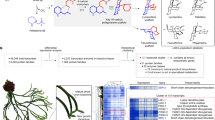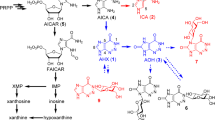Abstract
SINCE their discovery 150 years ago, alkaloids have been the subject of innumerable research papers, practically all of which have been concerned with the occurrence, production in the plant and properties of the final molecular species. Even when the plant produces a series of closely related alkaloids, it has normally been considered sufficient to show their order of formation and which was the ultimate molecule. In all this work the tacit assumption has been that alkaloids are the end-products of interesting biosynthetic sequences and that functionally they represent slowly accumulating heaps of metabolic sludge. Only rarely is there any evidence of return to metabolic circulation and the quantities involved are extremely small1. However, some workers have shown that nicotine, which itself is derived partly from nicotinic acid2, may not be an end-product substance but suffers extensive metabolic change, acting as a methyl donor to choline3 and is also incorporated into insoluble organic substances4, related alkaloids, amino-acids, sugars and other common metabolites5. Another approach has been to study the variation in alkaloidal pattern during plant growth; Hemberg and Flück6 found some variation in total alkaloids in Datura species at 4-h intervals, and Hevdenreich and Pfeifer7 have demonstrated marked variation in the alkaloidal pattern in Papaver somniferum fruits at 6-h intervals. These variations suggest a dynamic role for the alkaloids, and our own work on developing fruits of Conium maculatum and Papaver somniferum has shown that even more marked variations occur at 3-, 2-and 1-h intervals8–10. Furthermore, our results indicate that the major alkaloids, coniine and morphine, respectively, disappear rapidly soon after formation, again indicating that they are not ‘dead-end’ substances but may be the precursors of non-alkaloidal substances of metabolic significance. In order to confirm this and gain further information on the problem, we carried out a preliminary experiment by feeding radioactive morphine (the major alkaloid) to poppy plants (Papaver somniferum L.) in 1963. Examination of the fruits a few days later showed that the morphine had been converted into non-alkaloidal substances; accordingly, we decided to repeat the experiment more carefully the following year.
This is a preview of subscription content, access via your institution
Access options
Subscribe to this journal
Receive 51 print issues and online access
$199.00 per year
only $3.90 per issue
Buy this article
- Purchase on Springer Link
- Instant access to full article PDF
Prices may be subject to local taxes which are calculated during checkout
Similar content being viewed by others
References
James, W. O., Endeavour, 12, 76 (1953).
Dawson, R. F., Christman, D. R., D'Adamo, A., Solt, M. L., and Wolf, A. P., J. Amer. Chem. Soc., 82, 2628 (1960).
Leete, E., and Bell, V. M., J. Amer. Chem. Soc., 81, 4358 (1959).
Tso, T. C., and Jeffrey, R. N., Arch. Biochem. Biophys., 80, 46 (1959).
Tso, T. C., and Jeffrey, R. N., Arch. Biochem. Biophys., 92, 253 (1961).
Hemberg, T., and Flück, H., Pharm. Acta Helv., 28, 74 (1953).
Heydenreich, K., and Pfeifer, P., Scient. Pharm., 30, 164 (1962).
Fairbairn, J. W., and Suwal, P. N., Phytochemistry, 1, 38 (1961).
Fairbairn, J. W., and Wassel, G., Phytochemistry, 3, 253 (1964).
Fairbairn, J. W., Paterson, A., and Wassel, G., Phytochemistry, 3, 577 (1964).
Fairbairn, J. W., and Kapoor, L. D., Planta Medica, 8, 49 (1960).
Author information
Authors and Affiliations
Rights and permissions
About this article
Cite this article
FAIRBAIRN, J., PATERSON, A. Alkaloids as Possible Intermediaries in Plant Metabolism. Nature 210, 1163–1164 (1966). https://doi.org/10.1038/2101163a0
Issue Date:
DOI: https://doi.org/10.1038/2101163a0
Comments
By submitting a comment you agree to abide by our Terms and Community Guidelines. If you find something abusive or that does not comply with our terms or guidelines please flag it as inappropriate.



